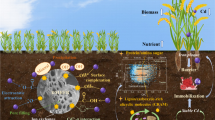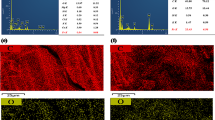Abstract
Microorganisms play a key role in degradation of polycyclic aromatic hydrocarbons (PAHs) in environments. Dissolved organic matter (DOM) can enhance microbial degradation of PAHs in soils. However, it is not clear how will the soil microbial community respond to addition of DOM during bioremediation of PAH-contaminated soils. In this study, DOMs derived from various agricultural wastes were applied to remediate the aging PAH-contaminated soils in a 90-day microcosm experiment. Results showed that the addition of DOMs offered a more efficient and persistent elimination of soil PAHs compared to the control which had no DOM addition. PAH removal effects were different among treatments with various DOMs; the addition of DOMs with high proportion of hydrophobic fraction could remove PAHs more efficiently from the soil. Low-molecular-weight (LMW) PAHs were more easily eliminated than that with high-molecular-weight (HMW). Addition of DOMs significantly increased abundance of 16S ribosomal RNA (rRNA), pdo1, nah, and C12O genes and obviously changed community compositions of nah and C12O genes in different ways in the PAH-contaminated soil. Phylogenetic analyses of clone libraries exhibited that all of nah sequences and most of C12O sequences were affiliated into Gammaproteobacteria and Betaproteobacteria. These results suggested that external stimuli produced by DOMs could enhance the microbial degradation of PAHs in soils through not only solubilizing PAHs but also altering abundance and composition of indigenous microbial degraders. Our results reinforce the understanding of role of DOMs in mediating degradation of PAHs by microorganims in soils.




Similar content being viewed by others
References
Johnsen AR, Wick LY, Harms H (2005) Principles of microbial PAH-degradation in soil. Environ Pollut 133:71–84
Peng RH, Xiong AS, Xue Y, Fu XY, Gao F, Zhao W, Tian YS, Yao QH (2008) Microbial biodegradation of polyaromatic hydrocarbons. FEMS Microbiol Rev 32:927–955
Niepceron M, Martin-Laurent F, Crampon M, Portet-Koltalo F, Akpa-Vinceslas M, Legras M, Bru D, Bureau F, Bodilis J (2013) Gamma Proteobacteria as a potential bioindicator of a multiple contamination by polycyclic aromatic hydrocarbons (PAHs) in agricultural soils. Environ Pollut 180:199–205
Alcántara MT, Gómez J, Pazos M, Sanromán MA (2008) Combined treatment of PAHs contaminated soils using the sequence extraction with surfactant-electrochemical degradation. Chemosphere 70:1438–1444
Antizar-Ladislao B (2010) Bioremediation: working with bacteria. Elements 6:389–394
Librando V, Pappalardo M (2013) In silico bioremediation of polycyclic aromatic hydrocarbon: a frontier in environmental chemistry. J Mol Graph Model 44:1–8
Northcott GL, Jones KC (2001) Partitioning, extractability, and formation of nonextractable PAH residues in soil. 1. Compound differences in aging and sequestration. Environ Sci Technol 35:1103–1110
Luo L, Lin S, Huang HL, Zhang SZ (2012) Relationships between aging of PAHs and soil properties. Environ Pollut 170:177–182
Kobayashi T, Murai Y, Tatsumi K, Iimura Y (2009) Biodegradation of polycyclic aromatic hydrocarbons by Sphingomonas sp. enhanced by water-extractable organic matter from manure compost. Sci Total Environ 407:5805–5810
Cheng KY, Wong JWC (2006) Combined effect of nonionic surfactant Tween 80 and DOM on the behaviors of PAHs in soil-water system. Chemosphere 62:1907–1916
Marschner B, Kalbitz K (2003) Controls of bioavailability and biodegradability of dissolved organic matter in soils. Geoderma 113:211–235
Yu H, Huang GH, An CJ, Wei J (2011) Combined effects of DOM extracted from site soil/compost and biosurfactant on the sorption and desorption of PAHs in a soil-water system. J Hazard Mater 190:883–890
Mei Y, Wu FC, Wang LY, Bai YC, Li W, Liao HQ (2009) Binding characteristics of perylene, phenanthrene and anthracene to different DOM fractions from lake water. J Environ Sci (China) 21:414–423
Muckian LM, Grant RJ, Clipson NJW, Doyle EM (2009) Bacterial community dynamics during bioremediation of phenanthrene- and fluoranthene-amended soil. Int Biodeterior Biodegrad 63:52–56
Ringelberg DB, Talley JW, Perkins EJ, Tucker SG, Luthy RG, Bouwer EJ, Fredrickson HL (2001) Succession of phenotypic, genotypic, and metabolic community characteristics during in vitro bioslurry treatment of polycyclic aromatic hydrocarbon-contaminated sediments. Appl Environ Microbiol 67:1542–1550
Vinas M, Sabate J, Espuny M, Solanas M (2005) Bacterial community dynamics and polycyclic aromatic hydrocarbon degradation during bioremediation of heavily creosote-contaminated soil. Appl Environ Microbiol 71:7008–7018
Meynet P, Hale SE, Davenport RJ, Cornelissen G, Breedveld GD, Werner D (2012) Effect of activated carbon amendment on bacterial community structure and functions in a PAH impacted urban soil. Environ Sci Technol 46:5057–5066
Li XZ, Wu YC, Lin XG, Zhang J, Zeng J (2012) Dissipation of polycyclic aromatic hydrocarbons (PAHs) in soil microcosms amended with mushroom cultivation substrate. Soil Biol Biochem 47:191–197
Cunliffe M, Kertesz MA (2006) Effect of Sphingobium yanoikuyae B1 inoculation on bacterial community dynamics and polycyclic aromatic hydrocarbon degradation in aged and freshly PAH-contaminated soils. Environ Pollut 144:228–237
Khan S, Heshan A, Qing G, Shuang L, He JZ (2009) Biodegradation of pyrene and catabolic genes in contaminated soils cultivated with Lolium multiforum L. J Soils Sediments 9:482–491
Tuan NN, Hsieh HC, Lin YW, Huang SL (2011) Analysis of bacterial degradation pathways for long-chain alkylphenols involving phenol hydroxylase, alkylphenol monooxygenase and catechol dioxygenase genes. Bioresour Technol 102:4232–4240
Han XM, Liu YR, Zheng YM, Zhang XX, He JZ (2014) Response of bacterial pdo1, nah and C12O genes to aged soil PAH pollution in a coke factory area. Environ Sci Pollut Res 21:9754–9763
Johnsen AR, de Lipthay JR, Sørensen SJ, Ekelund F, Christensen P, Andersen O, Karlson U, Jacobsen CS (2006) Microbial degradation of street dust PAHs in microcosms simulating diffuse pollution of urban soil. Environ Microbiol 8:535–545
Baldwin BR, Nakatsu CH, Nies L (2003) Detection and enumeration of aromatic oxygenase genes by multiplex and real-time PCR. Appl Environ Microbiol 69:3350–3358
Sei K, Asano K, Tateishi N, Mori K, Ike M, Fujita M (1999) Design of PCR primers and gene probes for the general detection of bacterial populations capable of degrading aromatic compounds via catechol cleavage pathways. J Biosci Bioeng 88:542–550
Lu RK (1999) Analysis methods of soil agrichemistry. China Agricultural Science and Technology Press, Beijing
USEPA (2000) Method 3550C, test methods for evaluating solid waste. EPA SW-846, 3rd edn. US Government Print Office, Washington
Lillis L, Clipson N, Doyle E (2010) Quantification of catechol dioxygenase gene expression in soil during degradation of 2,4-dichlorophenol. FEMS Microbiol Ecol 73:363–369
Lv BY, Xing MY, Yang J, Qi WS, Lu YS (2013) Chemical and spectroscopic characterization of water extractable organic matter during vermicomposting of cattle dung. Bioresour Technol 132:320–326
Song NH, Zhang S, Hong M, Yang H (2010) Impact of dissolved organic matter on bioavailability of chlorotoluron to wheat. Environ Pollut 158:906–912
Kukkonen J, McCarthy JF, Oikari A (1990) Effects of XAD-8 fractions of dissolved organic carbon on the sorption and bioavailability of organic micropollutants. Arch Environ Contam Toxicol 19:551–557
Maxin C, Kogel-Knabner I (1995) Partitioning of PAH to DOM: implications on PAH mobility in soils. Eur J Soil Sci 46:193–204
Liang YT, Van Nostrand JD, Deng Y, He ZL, Wu LY, Zhang X, Li GH, Zhou JZ (2011) Functional gene diversity of soil microbial communities from five oil-contaminated fields in China. ISME J 5:403–413
Block JC, Mathieu L, Servais P, Fontvieille D, Werner P (1992) Indigenous bacterial inocula for measuring the biodegradable dissolved organic carbon (BDOC) in waters. Water Res 26:481–486
Wick LY, Ruiz de Munain A, Springael D, Harms H (2002) Responses of Mycobacterium sp. LB501T to the low bioavailability of solid anthracene. Appl Microbiol Biotechnol 58:378–385
Bogan BW, Lahner LM, Sullivan WR, Paterek JR (2003) Degradation of polycyclic aromatic and straight-chain aliphatic hydrocarbons by a strain of Mycobacterium austroafricanum. J Appl Microbiol 94:230–239
Wells M, Wick LY, Harms H (2005) Model polymer release system study of PAH bioaccessibility: the relationship between rapid release and bioaccessibility. Environ Sci Technol 39:1055–1063
Uyttebroek M, Breugelmans P, Janssen M, Wattiau P, Joffe B, Karlson U, Ortega-Calvo JJ, Bastiaens L, Ryngaert A, Hausner M, Springael D (2006) Distribution of the Mycobacterium community and polycyclic aromatic hydrocarbons (PAHs) among different size fractions of a long-term PAH-contaminated soil. Environ Microbiol 8:836–847
Kennedy N, Edwards S, Clipson N (2004) Impact of lime, nitrogen and plant species on bacterial community structure in grassland microcosms. Environ Microbiol 6:1070–1080
Lors C, Ryngaert A, Périé F, Diels L, Damidot D (2010) Evolution of bacterial community during bioremediation of PAHs in a coal tar contaminated soil. Chemosphere 81:1263–1271
Acknowledgments
This study was financially supported by the Natural Science Foundation of China (41301567, 51221892, 21207049) and the International Cooperation Training Project Funding for Outstanding Middle-aged and Young Backbone Teachers in Colleges and Universities of Shandong Province. We are grateful to Dr. Qinzeng Xu of Institute of Oceanology, Chinese Academy of Sciences, for his assistance in data analysis.
Author information
Authors and Affiliations
Corresponding authors
Rights and permissions
About this article
Cite this article
Han, XM., Liu, YR., Zhang, LM. et al. Insight into the Modulation of Dissolved Organic Matter on Microbial Remediation of PAH-Contaminated Soils. Microb Ecol 70, 400–410 (2015). https://doi.org/10.1007/s00248-015-0575-x
Received:
Accepted:
Published:
Issue Date:
DOI: https://doi.org/10.1007/s00248-015-0575-x




